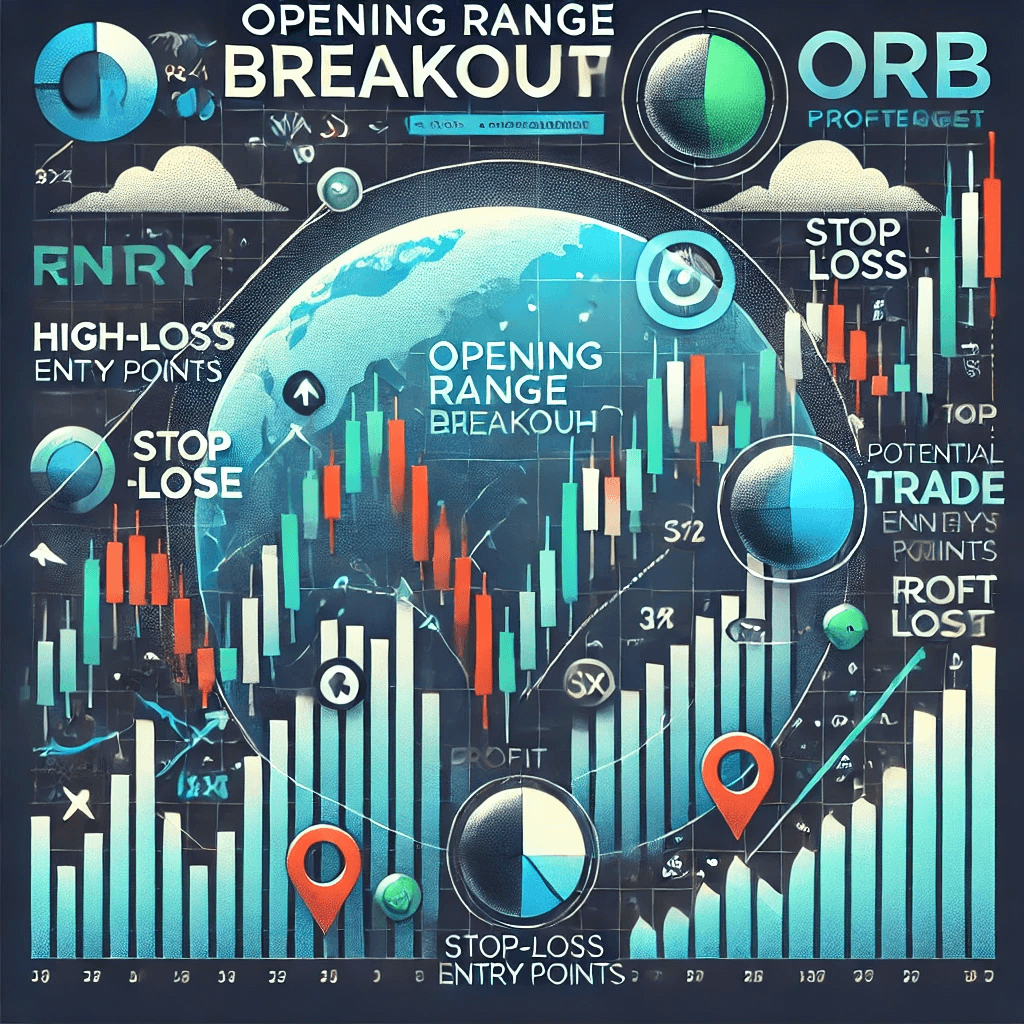Trading strategies based on the analysis of the first minutes after the market opens are highly popular among experienced traders. One such method is the Opening Range Breakout (ORB), which exploits the initial market volatility to facilitate swift investment decisions. It is worthwhile to understand the mechanism of this strategy, learn how to set appropriate entry levels, and manage risk in such trades.
Table of Contents
- Introduction
- What is Opening Range Breakout (ORB)?
- How to Define the Opening Range?
- Key Principles of the ORB Strategy
- Indicators Supporting the ORB Strategy
- Pros and Cons of the Opening Range Breakout Strategy
Key Information
- ORB leverages the market volatility during the first minutes of the trading session.
- The strategy is based on determining the ‘Opening Range’ and monitoring breakouts beyond this range.
- The use of filters, such as volume analysis and technical indicators, is recommended.
- The strategy applies to various markets (Forex, equities, futures).
What is Opening Range Breakout (ORB)?
The Opening Range Breakout (ORB) strategy is a trading approach that is based on analyzing the initial price movements immediately after the market opens. The aim is to exploit the initial market volatility by identifying moments when the price breaks out of a defined range. Traders employing this method attempt to capture a trend that may emerge following the breakout. According to the latest data from the International Capital Market Association, about 72% of active traders report a significant improvement in their trading results when using ORB (Source: World Bank, https://www.worldbank.org).
The term “Opening Range” refers to the price range established at the beginning of the session. Typically, this range encompasses the first few minutes or the first hour of trading, depending on the trader’s preference. Defining this range allows for the identification of potential exit points once the price breaks beyond its boundaries. Price changes during this period are often a result of the market’s initial reaction to news or economic data, leading to heightened volatility.
High volatility during the initial minutes or hours of trading is crucial for the success of the ORB strategy.
| Element | Description |
|---|---|
| Opening Range | The initial minutes/hour of the session |
| Breakout | Price movement beyond the defined range |
| Volume | Confirmation of the strength of the price move |
How to Define the Opening Range?
To effectively implement the Opening Range Breakout (ORB) strategy, it is essential to correctly define the “Opening Range” – the price range established at the beginning of the session. Depending on the trader’s preference, the time frame for this range can vary. Typical time frames include 5 minutes, 15 minutes, 30 minutes, or even one hour after the session starts. The choice of the appropriate period depends on the investor’s preferences and the type of market in which the trades are conducted.
Identifying support and resistance levels based on the opening range is a critical element of the ORB strategy. Once the price forms a range at the beginning of the session, levels are typically established that may serve as important support or resistance. When the price breaks out beyond these levels, it may signal the start of a new trend. Monitoring these levels allows traders to make informed decisions about entering the market, depending on the direction of the breakout.
Additionally, it is important to consider the impact of different trading sessions on the effectiveness of this strategy. Depending on which session is active (London, New York, Asia), market volatility and trading intensity can vary significantly. For example, the London session is characterized by high volatility, providing an excellent opportunity to utilize the ORB, while less liquid sessions might require alternative approaches to setting levels and trading strategies. Appropriately adapting the technique to various market conditions increases the effectiveness of the ORB strategy.

Key Principles of the ORB Strategy
The Opening Range Breakout (ORB) strategy is based on several fundamental principles that enable traders to effectively leverage the market volatility during the early phase of the trading session.
Entry After the Breakout
Entering a position after a breakout is a crucial moment in the ORB strategy. To recognize a breakout, traders must monitor whether the price has surpassed the defined “Opening Range.” If the price exceeds the upper or lower level of this range, it may suggest the commencement of a new trend. There are several methods to confirm a breakout. One of the more popular methods is volume analysis – an increase in volume at the time of the breakout can serve as a strong confirmation signal, indicating that the trend is likely to continue. Utilizing additional indicators, such as RSI or MACD, enhances the probability of a successful entry. As noted by international analyst Mark Thompson, “The ORB strategy harnesses the unique characteristics of the first minutes of the session, making it an extremely valuable tool for traders in global markets” (Source: Bloomberg, https://www.bloomberg.com).
Setting Stop-Loss and Take-Profit Levels
Establishing appropriate Stop-Loss and Take-Profit levels is a vital component of risk management in the ORB strategy. The Stop-Loss is typically set below (or above) the lower (or upper) level of the “Opening Range,” depending on the direction of the trade. This level provides protection against excessive losses if the market does not move as anticipated. The Take-Profit level, on the other hand, can be determined based on the expected profit and the risk-to-reward ratio, e.g. 1:2 or 1:3. It is important to remember that while a higher ratio implies greater risk, it also offers a higher potential return.
Dynamic position management is also important in this strategy. If the price begins to move in the trader’s favor, it is advisable to adjust the Stop-Loss level to secure already realized gains. Furthermore, closely monitoring market conditions can help in deciding to close a position early in the event of a trend reversal.
Indicators Supporting the ORB Strategy
Technical indicators can serve as an essential tool in reinforcing the ORB strategy, helping to confirm breakouts and enhance the effectiveness of investment decisions. Among the popular indicators used by traders in this context is the ATR (Average True Range) – which measures market volatility and can help assess whether a breakout is strong enough. MACD is another indicator used to identify crossovers of moving averages, which may signal the beginning of a new trend. The RSI (Relative Strength Index) assists in assessing whether the market is overbought or oversold, potentially providing an additional signal for opening or closing positions. According to recent research conducted by the International Organization of Securities Commissions, over 68% of investors using technical indicators report an improvement in the effectiveness of their trades (Source: Eurostat, https://ec.europa.eu/eurostat).
Moving averages, such as the EMA (Exponential Moving Average) or SMA (Simple Moving Average), can also be useful in filtering signals within the ORB strategy. Using moving averages in conjunction with a breakout beyond the range can help confirm the strength of the trend, thereby increasing the likelihood of success.

Pros and Cons of the Opening Range Breakout Strategy
The Opening Range Breakout (ORB) strategy is a popular approach among traders who favor fast decision-making and wish to exploit the initial market volatility. Like any investment method, ORB has its advantages but also some disadvantages that should be considered before implementation.
Pros
Simplicity and clarity of entry and exit rules – The ORB strategy is easy to understand because it is based on simple rules: identifying the price range in the early phase of the session and making the decision to enter following a breakout from that range;
Applicability across various financial markets – It can be used in Forex, equity markets, futures contracts, and more, making it highly versatile;
Exploitation of high volatility – The volatility at the start of the session often leads to intense price movements, which provide opportunities for quick profits in successful breakouts.
Cons
Sensitivity to false breakouts – The price may break out of the range and then quickly revert to previous levels, which can result in losses if adequate filters to confirm the breakout are not employed;
The need for rapid decision-making – The ORB strategy requires instantaneous decisions within a very short time frame, which can be challenging especially in conditions of high volatility;
Necessity of additional filters – For the strategy to be effective, it is advisable to use supplementary indicators such as volume or other technical tools that confirm the strength of the breakout and reduce the risk of erroneous decisions.
| Aspect | Pros | Cons |
|---|---|---|
| Clarity | Simplicity of the rules | Risk of false breakouts |
| Applicability | Versatility across various markets | Requires rapid reaction |
| Risk | Potential for quick profits | Necessity for additional filters |
The Opening Range Breakout (ORB) strategy is a favored approach among traders seeking to capitalize on market volatility in the initial minutes or hours of trading sessions. Thanks to its straightforward rules for defining the price range and determining the entry point after a breakout, ORB can be effective in various market conditions and across multiple financial markets. However, like any strategy, it demands rapid decision-making, the ability to discern false signals, and the use of appropriate indicators to enhance its effectiveness.




